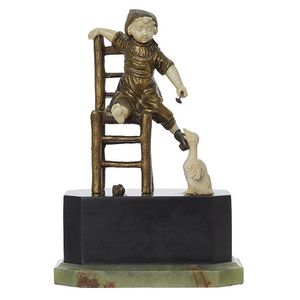Lost Clog: Whimsical Bronze and Ivory Figure
You must be a subscriber, and be logged in to view price and dealer details.
Subscribe Now to view actual auction price for this item
When you subscribe, you have the option of setting the currency in which to display prices to $Au, $US, $NZ or Stg.
- Ivory - Ivory is a hard white material that comes from the tusks of elephants, mammoth, walrus and boar, or from the teeth of hippopotamus and whales. The ivory from the African elephant is the most prized source of ivory. Although the mammoth is extinct, tusks are still being unearthed in Russia and offered for sale.
Ivory has been used since the earliest times as a material for sculpture of small items, both in Europe and the east, principally China and Japan.
In Asia ivory has been carved for netsuke, seals, okimono, card cases, fan supports, animals and other figures and even as carved tusks.
In the last 200 years in Europe ivory has been used to carve figures, for elaborate tankards, snuff boxes, cane handles, embroidery and sewing accessories, in jewellery and as inlay on furniture. Its more practical uses include being used for billiard balls, buttons, and a veneers on the top of piano keys.
The use and trade of elephant ivory have become controversial because they have contributed to Due to the decline in elephant populations because of the trade in ivory, the Asian elephant was placed on Appendix One of the Convention on International Trade in Endangered Species (CITES), in 1975, and in January 1990, the African elephant was similarly listed. Under Appendix One, international trade in Asian or African elephant ivory between member countries is forbidden. Unlike trade in elephant tusks, trade in mammoth tusks is legal.
Since the invention of plastics, there have been many attempts to create an artificial ivory - Bronze - An alloy of copper and tin, traditionally in the proportions of about 9 parts of copper to 1 part of tin.
The discovery of bronze in Western Asia in the 4th century enabled people to create metal objects which were superior to those previoulsy possible because of its strength and hardness, and it has been used throughout the world for weapons, coins, tools, statuary and other decorative items.
It is very fluid in a molten state, and its hardness, strength when set, and non-corrosive properties makes it most suitable for casting sculpture. - Onyx - Onyx is a form of agate, used from antiquity and popular again in the 1920s and 30s. European onyx is generally green, but can be many other colours, and can contain bands of black and/or white.
This multicoloured stone is widely used for table tops, lamp bases and in jewellery. Some types of onyx are also used for cameos of which the upper white layer is cut away to reveal the colour beneath. - Basalt - Basalt is a hard, dense volcanic rock formed from the rapid cooling of basaltic lava, and makes up most of the earth's oceanic crust.
However it is also the name given by Josiah Wedgwood in 1768 to a fine black unglazed porcelain which he called Wedgwood Black Basalt.
Using this fine-grained stoneware he was able to produce copies of the newly excavated Etruscan pottery from Italy, with a lustrous and smooth, surface, and this new innovation proved to be a huge commercial success.
This item has been included into following indexes:
Visually similar items

An Art Deco bronze and ivory figure cast of a violist on a marble plinth, signed Campbel on back. Provenance: Purchased in Berlin in 1925. 27 cm high.

Don Bradman, bronze statuette 'The Cover Drive - Sir Donald Bradman A.C.' by Fredric Whitehouse, Bradman Museum limited edition 343/500, 19 cm tall. G/VG condition.

A bronze Buddha seated on a low plinth, Sri Lanka, 19th century, a young full face looking forward with a slight smile, under the tightly curled hair with a flame shaped finial, wearing an off the shoulder robe, height 32 cm, width 23 cm. Provenance: An Am

Bali, hanging lamp, bronze, tear-drop shaped oil lamp burner with an arch-shaped armature frame supporting the figure of a male deity with one leg raised, 15 cm height
